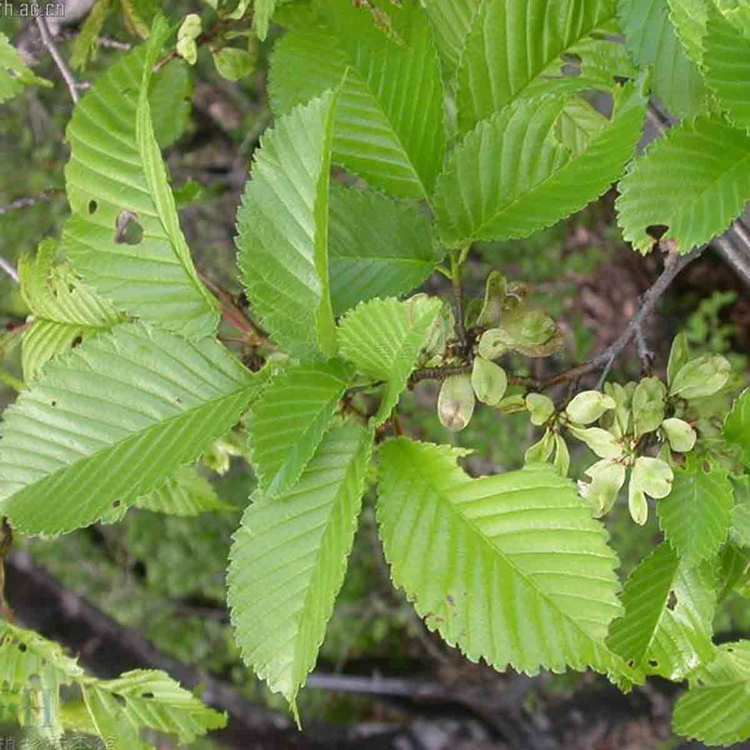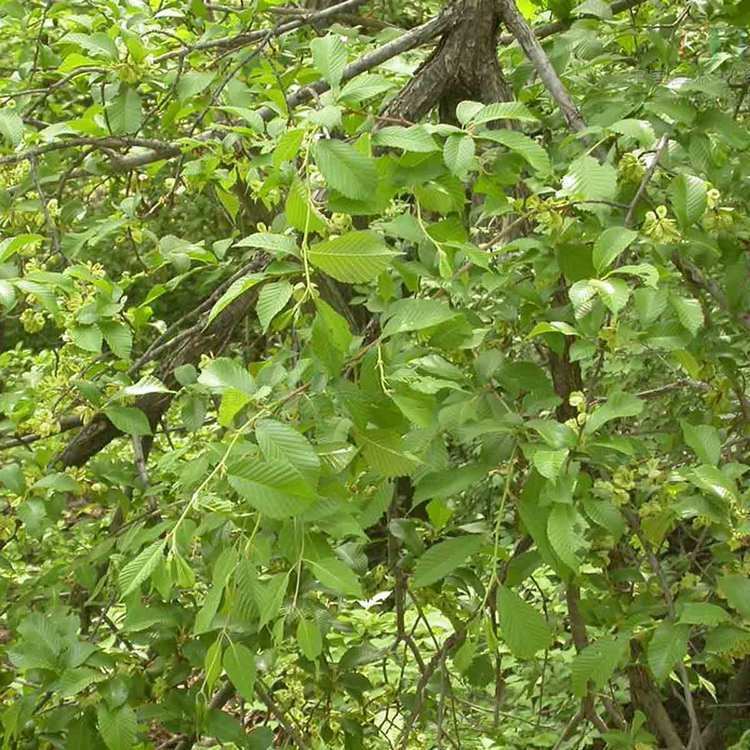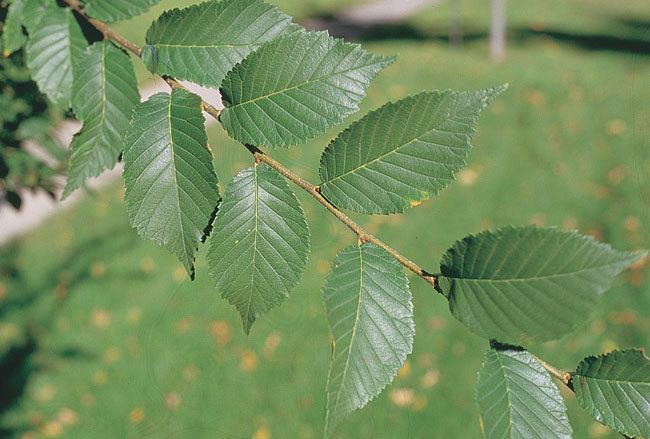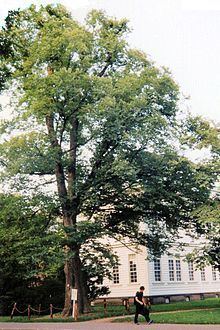Species U. davidiana Rank Variety | Genus Ulmus Higher classification Ulmus davidiana | |
Scientific name Ulmus davidiana var. japonica Similar Ulmus davidiana, Chinese elm, Ulmaceae, Ulmus pumila, Ulmus macrocarpa | ||
Ulmus davidiana var. japonica, the Japanese elm, is one of the larger and more graceful Asiatic elms, endemic to much of continental north-east Asia and Japan, where it grows in swamp forest on young alluvial soils, although much of this habitat has now been lost to intensive rice cultivation.
Contents
- Description
- Pests and diseases
- Cultivation
- Notable trees
- Hybrids cultivars and hybrid cultivars
- Accessions
- Nurseries
- References

Description

The size and shape of the Japanese elm is extremely variable, ranging from short and bearing a densely branched broad crown similar to the Wych elm to tall, single-stemmed, with narrow crown similar to the English elm. Augustine Henry described one of the latter outside Iwamigawa, Hokkaido, railway station as being 34 m tall, with a clean stem to a height of approximately 15 m. Japanese elm is distinguished by the fawn colour of shoots at the end of their first season, the shoots often being roughened by minute terbercles or 'warts'. The young shoots often bear corky wings, similar to those of the European field elm U. minor, to which it is closely related. The leaves are generally obovate, < 11 cm long, and with a coarse upper surface. Like many of the European field elms, var. japonica retains its green foliage well into the autumn, before a late display of deep yellow. Bean noted that the variety from western China, formerly known as U. wilsoniana, has 16 to 22 pairs of leaf-veins, while the eastern type tree has not more than 16. The perfect, apetalous wind-pollinated flowers emerge in early spring, before the leaves. The samara, <15 mm long, is obovate to orbicular, occasionally hairy over its entire surface but more often glabrous, the seed touching the notch, the inner margins of which are ciliate, the stigmas being slightly incurved. Trees grown from seed at Great Fontley in southern England first flowered aged 13 years.
Pests and diseases

Natural populations of Japanese elm have a low to moderate resistance to Dutch elm disease. In trials in the Netherlands, susceptibility to disease was found to be commensurate with rate of growth, the more vigorous specimens exhibiting far more foliar damage after inoculation with the causal fungus. Careful selection in North America has produced a number of cultivars highly resistant to disease (see Hybrids, hybrid cultivars and cultivars below). The tree is resistant to the elm leaf beetle Xanthogaleruca luteola [6] but is moderately susceptible to elm yellows.
Cultivation
Japanese elm has been widely planted in northern Japan as a street tree. It was introduced to North America in 1895 as seed sent from Sapporo to the Arnold Arboretum, Massachusetts, whence two seedlings were donated to Kew Gardens, London, in 1897. The Späth nursery, Berlin, marketed Japanese elm in Europe from 1900, Kew obtaining a third specimen from them in that year. Specimens were supplied by Späth to the Royal Botanic Garden Edinburgh in 1903 as U. campestris japonica and may survive in Edinburgh, as it was the practice of the Garden to distribute trees about the city. The Arnold Arboretum specimens grew rapidly, and first flowered aged 12 years. A form from western China, for many years distinguished as U. wilsoniana Schneider, was introduced to the Arnold Arboretum in 1910. Unlike many Asiatic species, Japanese elm is tolerant of a mild, maritime climate with heavy winter rainfall and was consequently considered of potential use in the Dutch elm breeding programme led by H. M. Heybroek at the Dorschkamp Research Institute at Wageningen. In 1977, Heybroek collected the tree in Japan, with the result that there is now a small forest of Japanese elm in southern Flevoland, the largest plantation of the species beyond its native land.

Specimens planted at the Sir Harold Hillier Gardens in Hampshire, England, in 1977 have grown very well on heavy clay in an open location, where they support colonies of the White-letter Hairstreak Satyrium w-album. In trials elsewhere in Hampshire conducted by Butterfly Conservation, the tree also proved tolerant of dry soils on chalk and soils waterlogged in winter, although growth has been comparatively slow. The species is not known to sucker from roots.
Leaves from the tree were eaten during the Great Chinese Famine, but found to cause facial swelling.
Notable trees
Japanese elm features prominently as a campus elm in Hokkaido University, Sapporo, and in the University Botanical Gardens.
In the UK, the TROBI Champion grows at the Sir Harold Hillier Gardens, Romsey, measuring 13 m high by 42 cm d.b.h. in 2003. A possibly larger specimen grows on the Sussex University at Falmer, Brighton, but may be the cultivar 'Jacan'. The oldest specimen in Edinburgh has a bole-girth 3.5 m (2016). Four mature specimens of Japanese elm (the largest with a bole-girth 2.9 m) stand on Leith Links (2013), near the former Leith Academy buildings.
Hybrids, cultivars, and hybrid cultivars


Japanese elm was assessed in Canada as a substitute for native elms which had succumbed to Dutch elm disease. A number of particularly hardy cultivars were released there in the 1980s; three cultivars were also raised in the United States [7]: 'Discovery', 'JFS-Bieberich' = Emerald Sunshine (formerly treated under U. propinqua Koidz.), 'Freedom', 'Jacan', 'Mitsui Centennial', 'Prospector' (formerly treated under Wilson's elm U. wilsoniana C.K. Schneid.), 'Reseda', 'Thomson', Validation However, most of the Canadian clones have now been withdrawn from commerce owing to the Canadian government's restrictions on the movement of elm within the country, adopted to prevent the spread of Dutch elm disease.
The Japanese elm was widely used in the USA in hybridization experiments at the Morton Arboretum and University of Wisconsin, resulting in the release of the following cultivars: 'Cathedral', 'Morton' (Accolade), 'Morton Glossy' (Triumph), 'Morton Plainsman' (Vanguard), 'Morton Red Tip' (Danada Charm), 'Morton Stalwart' (Commendation), 'New Horizon', 'Patriot', 'Rebona', 'Repura', 'Revera', and 'Sapporo Autumn Gold'.
The species has also been crossed with Dutch hybrids by the Istituto per la Protezione delle Piante (IPP) in Florence, Italy. Two clones, 'FL 610' and 'FL 626' are currently (2015) under evaluation in England by Butterfly Conservation.
